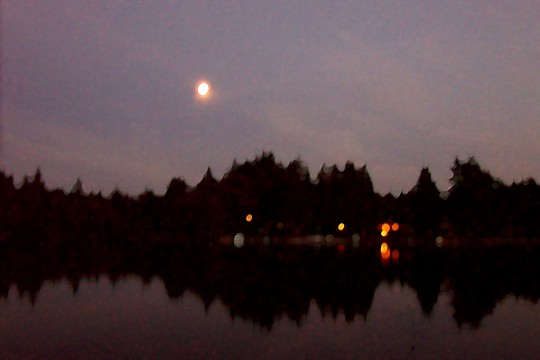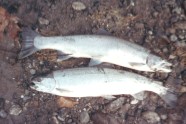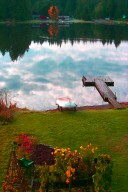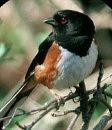Life at the Lake
a diary of living at a small lowland lakeWHAT IT'S LIKE

Early moonrise over Lake Ketchum
|
Archive Search |
| Links |
|
and s-integrator |

Three mallard ducklings
Now we are three
The natural attrition among critters is astonishing. What's more, it is depressing.
Earlier I reported a mallard brood of seven. This was about three weeks ago. Every few days I'd see the hen and count her ducklings. Seven. . . six . . . five. The day before yesterday I saw her steaming across the lake (where it is safe, I presume, from certain predators) and heading for the area near my dock. Just then a trout hit my set line and I and the dogs bolted for it. By this time she had reached the sedges and cattails.
Inadvertently I startled her and she flushed. The brood has grown large but apparently unable yet to fly. Off she and they scurried. One of them seemed to panic more than the others and was slow to catch up in open water.
I got my trout and looked round. They were gone, having taken top-water flight. Of course I posed no real threat; the escape mechanism is strong in many creatures and especially so in domestic cats. It seems to occupy a large part of their day. Yet something is getting the mallard's ducklings, one by one. I've never seen it take place.
Feral cats, raccoons, foxes (if we have any), certain breeds of dogs, I suppose: I can only guess at the kinds of predators.
Yesterday I saw she had but three ducklings. They were almost as large as her. I don't suppose that she thinks about what has happened to all of them (as I continue to do).
She goes on, attending to her diminished brood, and life goes on, too, as they are "erased" from earth's bounty.
- - Comments ()
...

Two hatchery fish, these steelhead
What—if anything—really matters?
I met with George Pess of the National Marine Fisheries Service at the C-Post bridge on the North Fork of the Stillaguamish River this morning and we inspected a series (5) of engineered log jams from a few years back. All are in place and still functioning.
These are artificial woody devices installed in rivers lacking the natural recruitment of logs that help the river create deep pool and swift riffles. If the river is over-developed, heavily logged in the past, it no longer can provide the trees the rivers need to build healthy habitat for fish. The river either goes without and loses its reproductive capability of salmon and steelhead, or it gets helped by knowledgeable field scientists like George.
The five ELJs have held in place now for about four years, some of them collecting and giving up logs, but the original base logs are all still in position (except for one, out of dozens, which was marginal at the time it was installed). What they do is create deep pools in which Chinook salmon can "ripen" and prepare to spawn in the riffles immediately upstream.
George oversaw this work, these installations, as part of his job, working with other agency people from the state and two effected Indian tribes. The hope was to increase salmon production in a reach of this fine river that has lost an alarming percentage of its Chinooks. And has it worked?
Not quite. It will take more than a handful of logjams to improve spawning conditions enough so the greatly reduced populations of adults and juveniles will rebound. The dire situation calls for many remedies implemented in succession over a short period of time—a few years.
There has been no noticeable improvement yet. The life cycle of the Chinook is highly dependent upon time spent at sea. It would seem that more and more young fish are reaching the saltwater but are not finding beneficial conditions there.
And, as we are recently learning, the sea are being mined by the world's fishing fleets. The Chinooks may be lost to long-line nets there before they are big enough to be deemed "keepers."
It is possible the are being trapped in the nets and thrown, dead, overboard because they have no market value. And this would explain, if true, why so few of them are returning to their natal rives to spawn.
It is one theory, anyway, and field scientists like George Pess must consider them all, no matter how outlandish they may seem at first.
- - Comments ()
...
So, how did the lake monitoring exercise of Fathers' Day go? Well, I'll tell you. Remember, the way scientists (including we pseudo-scientists) do thing today is with the metric scale. And I've had trouble converting to it. But here goes:
A Secchi Disc is a flat metal plate, roughly two feet (see, I violate my own canon, right at the start) in diameter, painted with pretty black and white pie-shaped wedges designed to be seen under water at various depths until you can no longer see it.. The idea is, you lower it on its staunch rope slowly, all the while watching for it to disappear, that is, vanish visibly. Then you record the depth.
The rope is marked at metric intervals and, within meters, tenths of a meter. When the disc can no longer be seen, we stop lowering, pull up the rope, and read the depth of visibility it gave us. We are to do it twice, once from one side of the boat, and once from the other, to allow for visual distortion from overhead sunlight.
Sunday my readings were 2.65 and 2.4 meters. These I recorded on a special form furnished by the county for EPA standards.
Then I went on to record air temperature (22 degrees Celsius), near-surface water temperature (19 degrees C.), and lake level, as measured by a gauge down at the far end of the lake, where the water gate is. But I have extrapolated the gauge height to my own dock piling, and can read the lake's true height within one-half of a tenth of a foot. (There I go again, mixing my units of measure.)
I then quickly complete a series of visual checks: algae in water, algae scum, aquatic plants, odor, odor if any (fishy, rotten egg, musty, septic-like). All today, and most days, are within target range.
Next come "approximate number of ducks and geese on lake." These are minimal today, but I note the arrival a few weeks ago of seven whitish domestic ducks. They came from someone's pond, probably under cover of darkness, and have been here ever since; they cannot fly, but merely flutter, but they can swim away pretty fast. Their presence annoys many of the lake residents.
Then: percent of cloud cover, rain within last 2 days (five degrees of raininess) , current wind conditions, and water color, which comes in 10 shades. I answer 75none, breezy, and light brown.
I am next given a box in which to enter "other lake and watershed conditions; (e.g. oil, garbage, etc. Please describe," and a small space in which to write my observations. Usually I have some, but not today; today is most ordinary.
Now comes the tough stuff. I take a sample of dissolved phosphorous at one and five meters, placing them in a clean plastic bottle. I take a voluminous sample of water in a brown bottle that contains a mysterious chemical which will preserve the chlorophyll content of the suspended algae at a meter's depth. This, along with the phosphorous samples, must be kept cool (that is, refrigerated) for two days, until my cooler with ice is emptied by people from the Surface Water Utility at some where near 9 AM Monday. I leave it at my front gate for pick up.
That wasn't really tough. What comes next is. The dissolved oxygen samples are complex and precise, and I dread the precise chemistry that will follow. First, though, a sample at the surface, 3 meters and 5 meters, the last of which is determined to be just off the bottom but not so close as to mix muck in with the clean water. Then there is a duplicate test sample, just to make sure I am doing it right, and I get to select the depth of the duplicate I take. I choose, Surface.
I lower my heavy plastic Vertical Sampler to each depth, trigger the release lever by sliding a brass weight down its rope that traps the water at that level inside the sampler, and haul the sampler back to the surface. I then decant the water each time into a glass sample bottle. They are labeled A, B, C, D, and Duplicate. These are so identified on the form I must complete.
This takes a whale of a lot of time in a boat pitching in the waves on its anchor.
I add to each bottle, quickly but deftly, 8 drops of Manganous Sulfate from bottle 1 (not remembering to wear gloves and safety glasses, as instructed, which I've not been issued and, if I were, probably wouldn't wear, anyway), allowing the precipitate to mix and settle two times.
Then I repeat the exact same scenario with Alkaline Potassium Iodide from bottle number 2. When it has settled and there is no visible precipitate, I add one gram of Sulfamic Acid Powder from bottle 3 and shake vigorously. ( I try not to shake myself. Oh, where are the rubber gloves to protect my dear hands from acid burns? Instead, I rinse my hands in sweet lake water.)
I shake each sample bottle vigorously. Concurrent with taking the bottle samples, I've read the temperature at each of the levels and recorded them on the form I've been issued.
The bottles (4) are now fixed and I have eight hours, I'm instructed, to return to my Lab and complete the process.
In my Lab, or kitchen counter, I decant 20 ml from each bottle, one at a time, into a test tube and drop, one at a time, Sodium Thiosulfate (bottle 4) from a syringe into the tube until the liquid inside turns "pale yellow." Then I stop, put the tube aside, add 8 drops of Starch Indicator from bottle 5 into the tube, and watch the liquid turn violently purple/black. This it is supposed to do, and does not indicate an experiment gone bad.
Now I go back to the graduated syringe and add, again one drop at a time, more of the Sodium Thoisulfate to the test tube until the solution turns "white as paper). I am almost done, Gentle Reader.
I read off the side of the syringe the number of Sodium Thiosulfate used up, on a scale of 1 to 10. That tells me precisely (if I've done it correctly) how much life-sustaining dissolved oxygen is contained in the lake water at that depth.
Whew, and whew for you, if you've read this far.
In mid-June of 2003, at Lake Ketchum, in Washington State, the following DO/temp values were recorded:
Surface, 19 degrees C., 9 mg/L DO
Three meters, 15 degrees C., 7.5 mg/L DO
Five meters, 11 degrees C., 3.5 mg/L DO
Duplicate sample:
Surface, 19 degrees C., 9 mg/L DO
What is interesting to me, out of all of this amateurish lab work, is that by late summer the amount of DO near the bottom at 5 meters depth will be less than 1 mg/L. That is way too little to sustain life at that level.
Yet we have had no noticeable fish kill and still lots of marginal micro-organisms can be found living on the bottom.
What I want to know is Why.
- - Comments ()
...

Not a boat in sight, hooray!
How far will one-thousand trout . . . stretch? Farther than I'd thought.
Maybe it is because so many fishers today put back their catch. After all, anybody who wants to eat rainbow trout, or various species of salmon, can buy them at the grocery store. Including my beloved steelhead, which is nothing more than a rainbow trout that had gone to see and benefited grossly from what it found there to feed upon for a year or two.
On my lake trout are being caught regularly by fishers who know what they are up to. The trout change in their eating habits as the season progresses. They soon become accustomed bottom-feeders. The snails, leeches, larvae, worms, etc., they find there are too enticing to bother with whatever is making its way to the surface, or can be found trapped there in the skim.
Trollers moving slowly (slowly is the key) up the center of this shallow lake are steadily catching fish on a variety of lures. After doing my DO (dissolved oxygen) and temperature monitoring, Sunday past, I can see where there is a level a couple of meters down where the water is both full of oxygen and the temperature is cool. This is where the trout congregate, evidently. It is also where I find them when I am fishing from my dock.
Yes, I am catching trout regularly, though not for a couple of weeks now any in the greatly desirable 15-21 inch class. I am stuck with the smaller rainbows, but they are averaging close to a foot in length, which puts them a number of ounces short of a pound in weight.
Oh, yes. We have swimmers' itch this year, the first I've heard about it in this lake in the seven years we've been here, though it is common, even endemic, in lowland lakes like ours. And it is no coincidence that we were "gifted" with seven domestic ducks that can barely fly by some pond-owner who tired of them and brought them here, under the cover of darkness.
They are more likely to bear the pest that causes the short-lived disease. It will last about a week, and can be prevented by taking a shower immediately after leaving the water, so that it doesn't dry on you, and by using plenty of soap.
- - Comments ()
...

Another view of yesterday's towhee
Yesterday I maligned the sweet little towhee. I'm truly sorry. I woke this morning and, deaf as I am, heard the reported "To-ee" sound in the bushes outside my bedroom window. And I realized I was wrong. It is nice to hear and very different from the prevalent blackbird trill, which I've been listening to since February.
Sure, it might be sort of dumb, but, hey, many of us are, and it isn't fair to hold that against us, man or bird. The towhee has problems, one of them being eye-sight. Who of us is so sharp-eyed that he or she can honestly disparage someone who is less so, and tends to bump into window glass and has trouble going up and down stairs?
Towhee eat seeds, mostly, and the occasional spider, ant, snail, or other tiny living creature not highly regarded by us humans or considered edible by us. I do not mean to suggest that we try eating the rufous-sided towhee. So when I find one lying dead by my window, struck down by its failure to read air as glass, I will continue to pick it up with gloves, put it in one of those ubiquitous plastic bags, and place it gently but unceremoniously in the garbage can, awaiting Ultimate Disposal the following Thursday morning, which here in the country is pick-up day.
And I will continue to marvel at the towhee's coloration which, though a bit drab and excessively multi-colored, is quite easy on the eye and unique. Whoever designed the towhee's spectrum did a pretty fine job of it, I'd say.
- - Comments ()
...

Not a robin but a not-so-smart towhee
Consider for a moment, please, the rufous-sided towhee. It is common bird, and at hasty glance looks like a robin. Look again, and it reveals a red-breast, all right, but white on the belly and an unusual barred upper backside, which looks mottled.
The bird is about eight inches long and is named after its whistle or call, "Tow-ee," or something like that, or so I am told, having never quite heard what is called its "twill." Common and often sighted without clear identification, it is notable for a couple of reasons.
One is that it appears to be a pretty dumb bird. Yesterday it hopped up and down out from the door to my work area, and when I walked out and descended my cement steps toward the lake, it preceded me, step by step, always allowing a polite interval of two steps between us. I thanked it for its consideration and slowed my own step, since it showed no tendency to hurry its pace.
So down we went, slow step at a time, and when we reached the bottom of the flight of six, it conducted a pretty little hop and disappeared a few inches into some bushes. There it remained, secure in its belief that I would not follow it there, and it was right. (I am not a Bush Follower.)
Perhaps my towhee has a nest in there. My online bird guide tells me it might be so. They do it, all the time. And we have a good population of the attractively patterned bird. They are sighted often enough.
And the other reason to be cited for its professed dumbness?
It frequently flies into windows. If there are two windows at right-angles to each other, the dim-sighted towhee thinks there are none, no windows and attempts to fly a straight course towards a woodsy scene, with disastrous results. It strikes the glass with a dull thud, waking me from my painting or writing or reading, and I rush forward to see if one more towhee has committed unintentional suicide.
Happily the last smashed towhee survived its accident, and afterwards marched round in a daze, much as you or I might have, after producing such a thud. It looked drunk. Of course it was merely stunned. I hung around at my window, out of sick curiosity, just long enough to learn whether or not the towhee could still fly.
It could, and a moment later flew off not so surely into some scrub—to heal or perhaps to die, though I prefer not to think it was the latter.
- - Comments ()
...